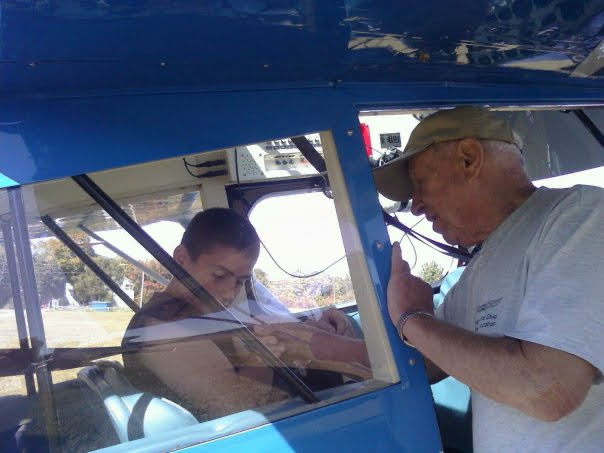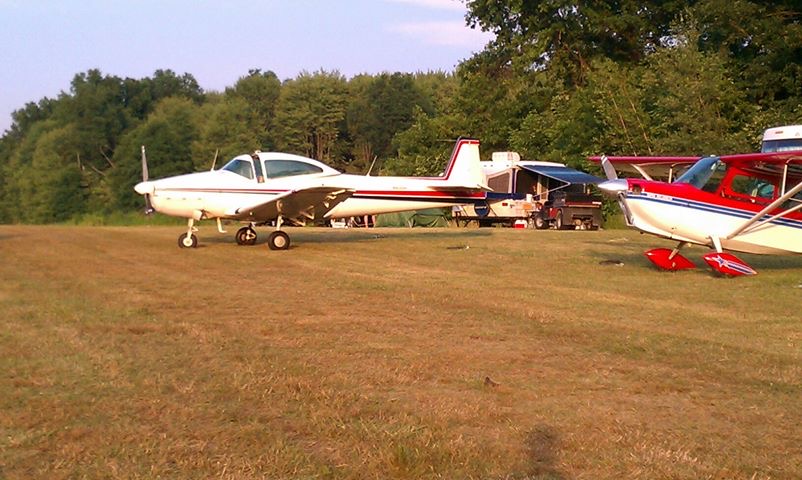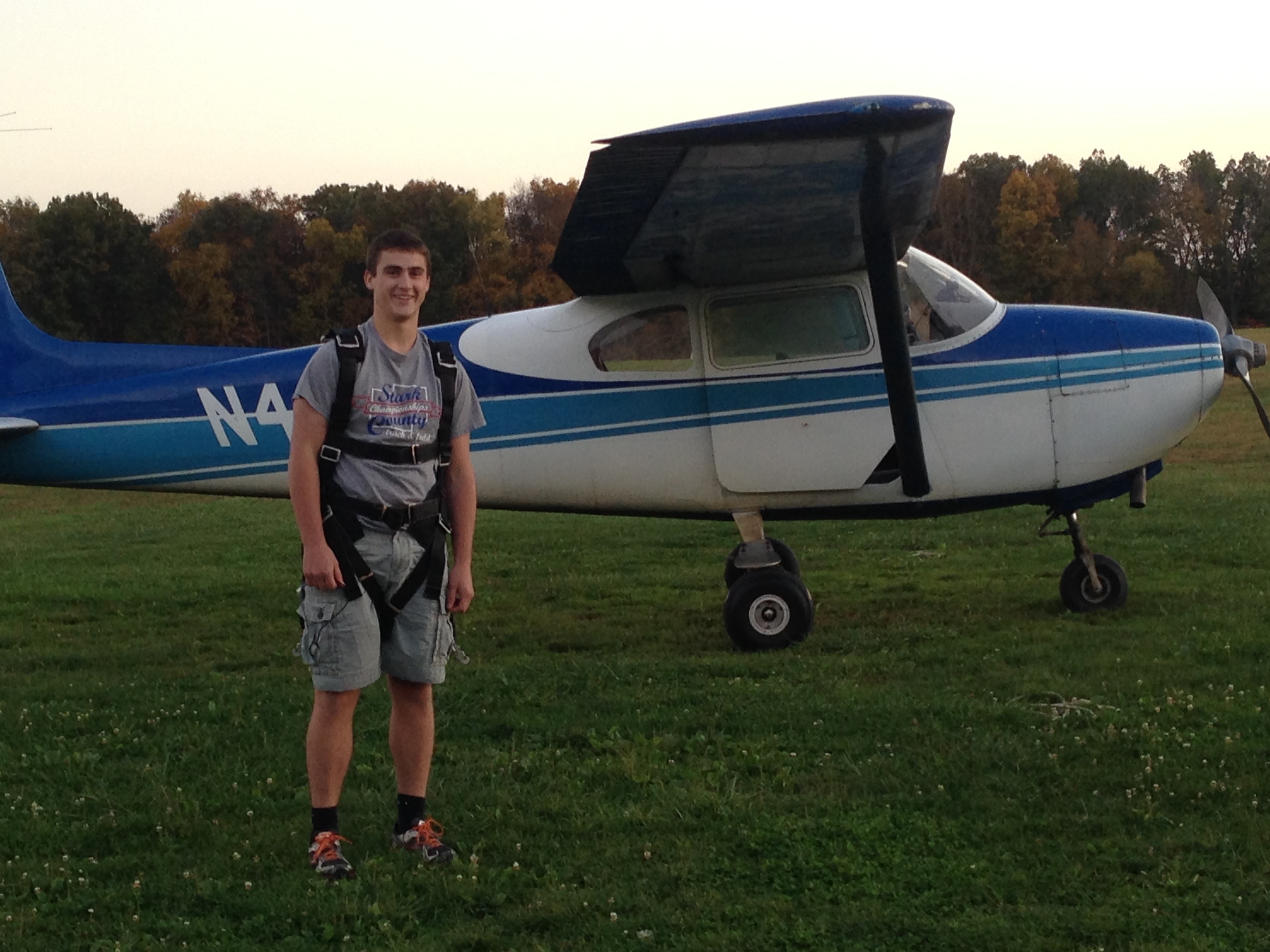On 2D1
Note: This a more narrative post. An homage in the attempted style of Bourdain.
The mornings at Barber Field often started cool, the sod field breathing a quiet mist that clung to the tall grass, blurring the edges of the aging hangars until the Ohio sun climbed high enough to burn it off. The sun didn’t shine… it pinned you down… made shade a thing to worship. Sometimes the first sound of the day was the faint, slightly tinny crackle of radio chatter drifting from an open hangar, followed by the hopeful, intermittent sputter of a Continental engine trying to clear its throat before settling into a confident roar. And always, as the heat built, the old corrugated metal hangars would sing their own tune, a rhythmic creaking and groaning as they expanded. This was Barber Airport, a place that grew on you like a fungus… not through flashy jets or the excitement of flights to Rio, but one perfect morning, one shared laugh, one story at a time. For an awkward, still-forming kid who already knew, deep down, that the sky was where the real business of life happened, Barber wasn’t just an escape… it was an education, a community, a proving ground. It was here, amidst this motley tribe and the beautiful, decaying grace of grassroots aviation, that a shy kid started to find his own frequency.
Barber wasn’t some sterile Signature FBO at a shitty mid-sized regional airport. This was a sod field, elemental and honest, its bumps and quirks telling their own silent stories. History wasn’t confined to dusty books here… you could feel it under your feet, in the air you breathed. It stood its ground, a stone’s throw from the original Taylorcraft factory, and that heritage, that direct lineage to aviation’s pioneering days, was like the airport’s DNA, informing everything. The field had deep roots. Forrest’s father, Al, had been a test pilot for Taylorcraft and literally dug this airfield from Ohio soil. Forrest carried that legacy as naturally as he wore his Taylorcraft trucker hat and “safari-guide shirts”… like it was just part of who he was, not something he had to prove. This connection to aviation’s golden age ran through everything at Barber. It drew the true believers: pilots who flew for the sheer, financially irrational, unadulterated love of it, who’d spend grocery money on avgas and call it a bargain. The annual Taylorcraft Fly-ins were the high holy days, less about the newest avionics and more about the collective, joyful cacophony of vintage engines, the easy exchange of hangar tales (some even brushing against the truth), the good-natured debates about who was making the pilgrimage to Oshkosh–aviation’s Mecca–that year, and of course, Patty’s cookies, which were a perfectly legitimate cross-country destination in their own right. To be there, even if Oshkosh was just a dream, was to be plugged into something authentic, something with grit and soul, something that started to feel, surprisingly, like belonging.

Forrest held court at the center of this universe, and God help you if you got him started on aviation. His ego wasn’t the flashy kind… it was the deep-rooted confidence of a man who’d forgotten more about aviation than most would ever learn. He could talk for hours, spinning stories like he was getting paid by the word. Sometimes you wondered if he just loved the sound of his own voice, but when those stories touched on aircraft, especially his beloved Taylorcrafts, every word carried weight. When Forrest had opinions about the FAA (“if you’re happy, they’re not happy”) or the latest Airworthiness Directive, you listened. His wisdom came wrapped in that calm Ohio drawl that became oh so familiar.
The old-timers loved telling stories about young Forrest’s mischievous streak. One of the stories that stuck with me was his favorite prank of yelling ‘Contact!’ across the field, making anyone hand-propping an engine jump out of their skin. The nickname stuck, though that prankster had mellowed into the patient mentor I knew. “You’ll be seeing a lot of me,” he’d told me after my first flight lesson. His theory was simple: hang around the airport enough, and the knowledge would soak in by osmosis. He was right. Day-by-day, I absorbed not just the mechanics of flight, but the unwritten rules of this world. For a quiet kid, his steady presence was a compass pointing true north.
My own immersion was gradual, a series of small initiations that slowly drew me further in. There was Billy. One afternoon, he gestured me over to his Citabria, a jaunty taildragger that always seemed eager to fly. “That’s ‘Airbatic’ spelled backwards, get it?” he’d grin, his uniform of well-worn, old-man jeans (that my family came to know as “Billy jeans”) practically a statement. I’d handled controls before, many times, but this was my first dance with this particular model, and my first flight with Billy. He let me take the stick, and for a few exhilarating moments, I felt the Citabria’s honest, lively spirit speaking directly through the controls. After he walked me through a few stomach-flipping power-off stalls, he “generously” offered me fifty bucks to wash and wax the bird. My arms felt like overcooked spaghetti for a week, and yeah, looking back, it was a hilariously lopsided deal. But that fifty bucks felt like an initiation fee into a club I desperately wanted to join… and $50 might as well be $10,000 to a 14 year old. It wasn’t just about the money… it was about being seen, being trusted with something real, a small validation that started to chip away at the shyness.

That sense of tentative belonging grew with characters like Brian, a respected name in Aeronca circles. One sun-drenched Ohio summer, he informally “took me under his wing.” Suddenly, I was part of a loose confederation with his sons, Joe and Stephen. Our collective attention span was embarrassingly short. We were always flitting from one half-formed idea to the next, a good portion of which involved elaborate, usually futile, strategies to convince passing pilots that what they really wanted to do was take a few kids up for a quick joyride. One weekend, our “major project” (which, in reality, consumed about half a Saturday) was the resurrection of a derelict go-kart. After some spirited mechanical improvisation, we got its tiny engine to cough, sputter, and finally roar into a semblance of angry life. For a few glorious hours, we were kings of the back forty, until Forrest ambled over and quietly suggested that our four-wheel Frankenstein would find its way to a landfill if we continued to tear up his cherished sod taxiways. Each small adventure, each shared laugh, each gentle rebuke, was another layer of insulation against awkwardness, another small push into the world.
The whole place just hummed with this barely contained energy, a constant, simmering stew of activity that was endlessly fascinating. Midday rituals usually involved a trek to ‘Shorty’s,’ the quintessential greasy spoon down the road. The coffee there was a respected local institution, smelling like it was made from cigarette butts and (ironically) tasting like jet fuel, but that just added to its charm. Forrest, of course, knew not just everyone’s name but probably their life story, holding court at the counter like it was his second office. Back at the field, you’d hear the curious, almost hypnotic whir of gyrocopters. Sometimes we’d even wander back to the Balsa Bees field, a smaller strip out back where RC plane enthusiasts, a dedicated group of middle aged dads in jorts and their sons, flew their beautiful, hand-crafted balsa wood creations and even held their own “fly-ins.” On the west side of the field, the skydiving operation pulsed with a different kind of vibe. They were a tribe apart, cheerful, sun-weathered adrenaline junkies who lived like aviation carnies out of a collection of well-traveled RVs parked haphazardly, their days ending with huge, crackling bonfires that threw dancing shadows on the hangar walls, their laughter carrying on the night air. My own airport adventures often involved tagging along with Forrest’s grandson, Daniel, armed with hissing metal detectors, eternally optimistic about unearthing Civil War relics (mostly, we found vintage beer cans and deeply rusted bolts). Or there were those drowsy summer afternoons by the field’s edge pond, where we cast our lines and soaked our shirts in ice water against the heat, the world narrowing to nothing but the distant hum of a Cessna overhead and the thick, humid air of another Ohio summer.
Patty was the airport’s conscience and its social glue, often the calm eye in the daily storm. You couldn’t really understand Barber without her. Her kindness was legendary, vast and unconditional, but so was her wit… sharp and unerringly accurate. One minute she’d be accosting Forrest, the next, turning with genuine concern to make sure this pudgy, perpetually hungry kid was properly fed or not about to attempt something terminally foolish.
That duality was pure Patty. I remember one Taylorcraft Fly-in, a brutal Ohio thunderstorm turning my cheap tent into a water raft. Patty materialized through the monsoon, a no-nonsense guardian angel armed with dry blankets, and marched me straight into the FBO. And “FBO” was putting it kindly. Forrest’s office and the adjoined sitting area was less a polished facility and more a living archive. “Pristine” was a foreign concept. Decades of flying magazines staged a coup against stacks of legal documents seemingly untouched since Nixon’s administration. Dusty two-ways held court with sun-faded photos of grinning pilots and their shiny birds. The furniture, tattered 70s cast-offs, sighed with comfortable exhaustion. And everywhere, amidst the aeronautical debris, the surprising iconography of Basset hounds, a tribute to Forrest’s Kelly Belle. A TV in the corner usually droned Fox News or the History Channel. In this curated chaos, Patty cleared a spot, fashioned a makeshift bed, and muttered under her breath about my poor choices in camping equipment. It wasn’t just shelter; it was her steady, reassuring presence, a kindness that made a kid feel seen.
Down the flight line, in his own meticulously ordered universe, Frank, an architect by profession, practiced a different, quieter kind of aviation devotion. His true cathedral was his hangar, his “nightly liturgy” the patient resurrection of classic aircraft. Evenings often found him there, under the stark hangar lights, periodically pausing to drag a forearm across his brow, wiping away sweat. His hangar wasn’t just a workshop… it was a portal. He had a Pietenpol Air Camper, “Sky Gypsy”, a gorgeous creation with a radial engine that he flew regularly. Another Pietenpol in his care was a local legend for its well-renowned lineage and buying price of $1. His then-current obsession was a WACO 9 he was bringing back from the brink, “Miss Gilmore.” I’d just stand there sometimes, a silent, fascinated observer, as he checked engine compressions or stretched fabric taut, slowly breathing life back into these winged phantoms.
Then there was “Cannonball” (I have no idea why they called him that). By the time our orbits intersected, he was an old salt, his professional flying days likely a good decade or two behind him. But Cannonball was the living embodiment of the dedicated “airport bum,” a title worn with quiet pride. He’d materialize around 9 a.m. every day, his arrival often preceded by the distinctive whine of his aging Cadillac’s problematic timing belt. He’d then proceed to inhabit the airport, often dispensing opinions or sometimes just napping on the porch, chin on his chest, soaking up the sun like an old lizard. Around 5 p.m., he’d stir and motor off, giving the impression he’d completed a profoundly important day’s work. His stories weren’t adrenaline-soaked epics but slower, drier, finely observed details that constituted the real texture of a life spent around airplanes.
The very air at Barber seemed saturated with learning, passed along not in classrooms, but through watching, doing, and hangar bull sessions. Ieuan, a sharp, thoughtful Welshman with an engineer’s meticulous brain for flight planning, would patiently unfold sectional charts with me. My first “$100 hamburger run” – a hallowed pilot tradition – became a “$100 pie run” with Ieuan. We flew to Carroll County Airport, a place spoken of in reverent tones for its divinely inspired, life-altering elderberry pie. The official mission: retrieve some aircraft part (I have idea which at this point). The real mission, of course, was the flight and a substantial, soul-satisfying slice of that legendary pie.
Then you had guys like Chris, younger than the old guard but already carrying the quiet competence of a seasoned pro, so dedicated he’d named his kids (Taylor, Curtiss) after aircraft manufacturers. A supremely gifted glider pilot, he once took me and Joe up in a run-of-the-mill 172. The landing was pure sorcery, so smooth we barely felt the wheels kiss the earth. Occasionally, Ryan, a respected regular from nearby Beach City Airfield, would visit. A teacher by trade, aviation was his native tongue, taught by his pilot father, Tim. Ryan was a Taylorcraft wizard, having built several, including a four-place model so rare it was spoken of in tones usually reserved for mythical creatures. His logbook bulged with thousands of hours, almost all in taildraggers, a testament to a skill and dedication already becoming a rarity. These were the people who gave that little corner of the aviation world its depth and character, each a thread in a rich, informal curriculum.

Barber Airport. It was always infinitely more than its sod runways and rusting hangars. It was a crucible where a diverse (often eccentric) collection of pilots, mechanics, dreamers, and storytellers forged a community that became a genuine home. Its essence was in the sudden burst of laughter from an open hangar… in the head-shaking frustration over a stubborn engine… in the collective, quiet pride when someone new got their certificate. It was in the wisdom passed from a calloused hand to an eager one. It was there, amidst the organized chaos, the scent of sun on grass, the distant drone of engines, and the endless, captivating stories, that a shy kid started to find his own voice, to trust his instincts, to feel like he was part of something real, something that mattered.
The sign out front bears a different name now. Years have spooled by. The silence left by some of those voices is a palpable thing. Forrest, the man who once, with a youthful “Contact!”, seemed to personify the airfield’s untamed spirit, the one who presided over Barber during my most formative years, flew west last year. His passing closed a long chapter. His truest legacy, for me, isn’t just in the skills he imparted or the history he preserved. It’s tied to the memory of that specific time, that unique alchemy of summer heat on metal, morning fog on a grass field, and the “osmosis” of learning that happened just by being there.
Blue skies, Barber Field. Thanks for the wisdom, the controlled chaos, and the irreplaceable space you held. We won’t see your like again.

